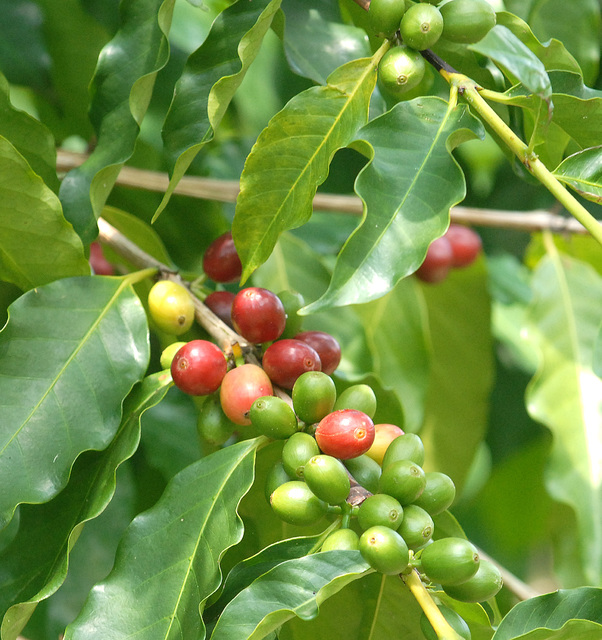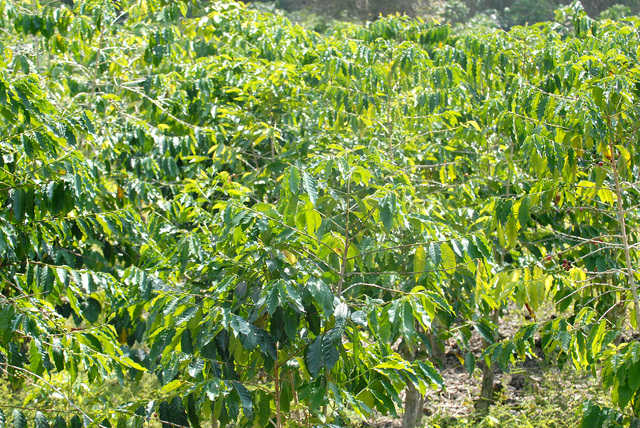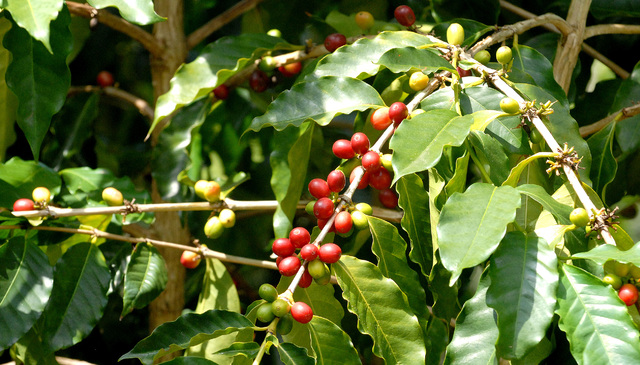Heavy rains damage coffee orchards but bring a bumper crop
Heading into the 45th annual festival showcasing their trade, Kona coffee growers have a lot to celebrate.
Abundant rain and an early and extensive coffee bloom have brought loads of cherry — filling drying platforms and mills with the fragrant product. But the rainfall has also been too much of a good thing, overloading the cherry with moisture, causing some of the fruit to split and drop their beans. And a series of significant flash floods this summer stripped away precious soil from some orchards and smothered others under a layer of silt.
“There is just a lot more Kona coffee for everyone this year,” said Kay Dixon, general manager of Sugai Products.
Sugai Kona Coffee comprises 88 acres in Holualoa and has roots that go back to the 1890s.
“The harvest started early and it’s going to be very long,” Dixon said. “We’ll probably be harvesting into January or February, which is atypical.”
A marathon bloom has helped boost Kona’s signature crop.
“This year they started blooming in the first part of January, and we had trees blooming into May and June,” Dixon said.
The bloom normally runs from February into April, she said.
A bumper crop can bring a downside. The sheer volume of coffee has pushed down prices somewhat, Dixon said. Sugai processes most of its own product, but the small amount of unprocessed cherry it does sell fetched only $1.80 this year, down from a top price of $2.25 last year, she said.
And pickers have become a scarce commodity, able to carefully choose which farms they wish to harvest.
“You have to take care of your pickers. There’s sort of a bidding war going on,” she said.
The rainfall helped propagate the fungus that kills the coffee berry borer naturally, Dixon said. However, the pest doesn’t appear to be going anywhere.
“It’s here to stay and I don’t know how we’re ever going to get rid of it,” she said.
Holualoa coffee farmer Bruce Corker said CBB seems to be under control and that this year’s crop should be “well above average.” More than 52 inches of rain fell in Holualoa in August and September, according to gauges on Corker’s farm.
Some farmers reported having trees uprooted and washed away, with the worst fields even becoming gullies and wastelands of rock and other debris.
Mary Robblee, a conservation assistant with the Kona Soil and Water Conservation District, visited 14 farms damaged by flooding and heard of impacts that extended beyond the areas she visited.
Farms with ground cover fared quite well, she said. Where farms practiced “clean culture,” or bare soil farming, the water stripped precious soil away, leaving roots exposed and trees vulnerable to die-off.
“Clean culture is not an effective way to farm here in Kona with the thin soils, steep slopes and heavy afternoon rains,” she said.
The damage wasn’t limited to a particular region, but was heaviest along existing waterways, which overflowed from the sheer volume of runoff.
“There was damage from one end of Kona to the other,” Robblee said.
The flooding has given farmers and property owners a lot to consider when they alter the landscape.
“What they do for themselves may not be in the best interest of those below them. That’s a challenge,” said Skip Bittenbender, an extension specialist with the University of Hawaii at Manoa College of Tropical Agriculture and Human Resources.
“There may need to be more coordination of people when they’re working on their farms,” said Bittenbender.
However, rainfall to the tune of up to four inches an hour in August and September led to widespread “sheet flows,” where the water volume was so great it was not limited to traditional channels. Robblee said it would be logistically intensive and expensive to address flooding even in localized areas, let alone the entire region. The building of sediment basins to absorb runoff would require permitting, land acquisition and other hurdles. Even then, benefits would be limited in their reach, and when the truly heavy rains fall, all bets are off, she said.
“It may not rain again like this in our lifetime,” Robblee said. “Or it might. People want assurance this will never happen again. We can’t guarantee that. It will rain, and the water will run downhill.”
Lester Ueda, county executive director at the U.S. Department of Agriculture Farm Service Agency, said that 10 West Hawaii farms reported flood damage during preliminary assessments in early October. But he said reporting is generally low initially as farmers work to solve their own problems.
Farmers will be able to apply for federal aid through the Emergency Conservation Program from Nov. 1 through Dec. 15, for cleanup and flood damage restoration, Ueda said. Generally more reports surface with the availability of the aid, he said.
“Some of the farms have a lot of debris,” said Ueda. “A lot of farm roads were damaged.”
Kealakekua farmer Maria Da Silva had portions of her coffee fields fill up with rock. Fences were torn down and gullies cut through her farm. Seventy-one trees washed away during a severe downpour in late September.
“We’re just now getting back on our feet, which is good because we still have a lot of coffee on the trees,” said Da Silva, owner of Kona Rising Coffee Co. “For some people, it’s going to be a great season. The cherry we have had has been great.”
“And it’s going to make what’s there taste all that much better.”








